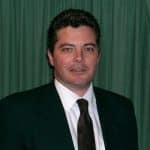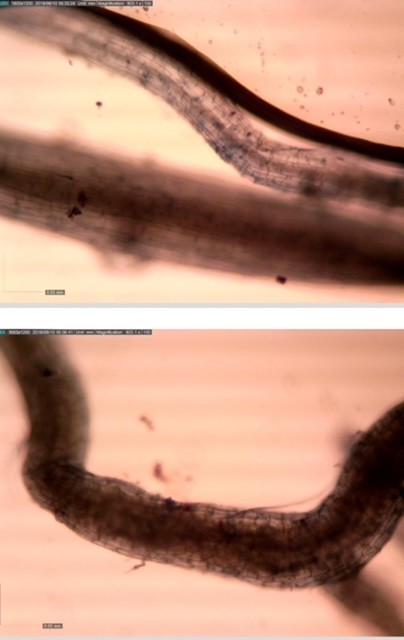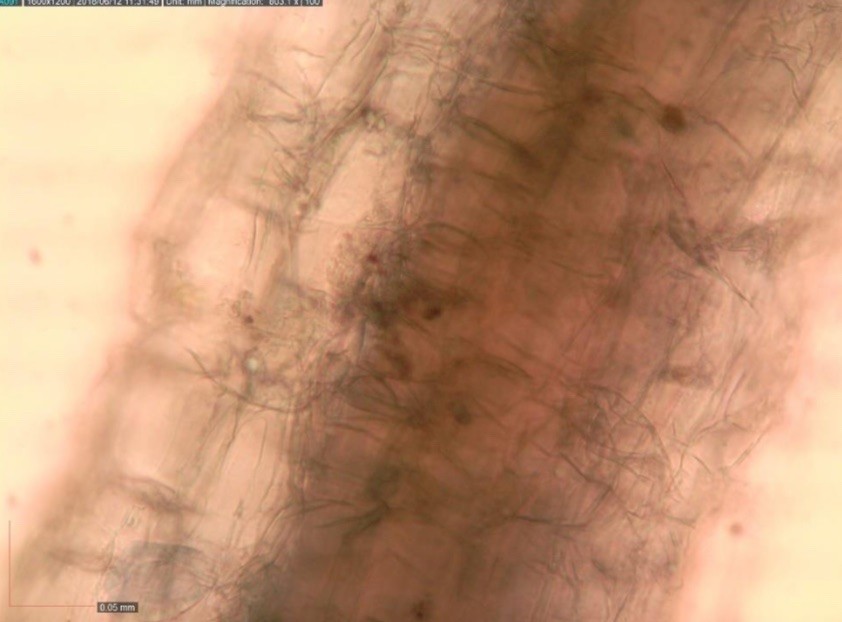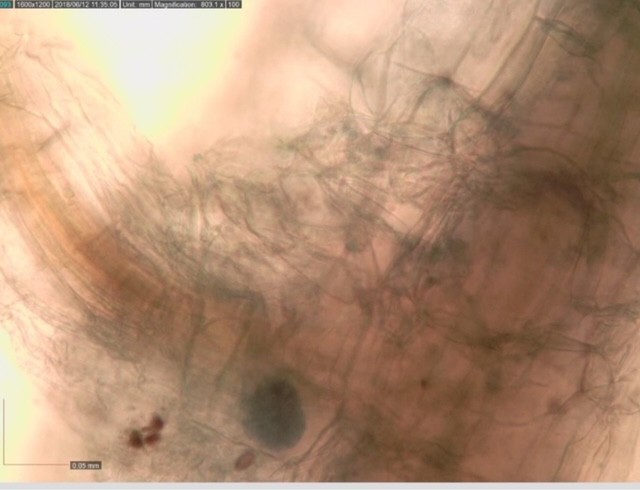This article is the second part of our blog on biostimulant use in turf. In this, we discuss the role of Trichoderma fungae and Mycorrhiza. Both of these are live biostimulants. Being live organisms, they are more tricky to get to work, as outside factors such as fungicide use can kill them. If you find this of interest you will also like our recent research into two novel bioactive compounds.
With chemical biostimulants like Vertmax Duo, which contains salicylic acid, applying fungicides has no direct impact on these.
Several products in the turf industry claim to increase the number of live soil microbes, with little data to support these claims.
The reasons why these claims are questionable are simple:
- At the label rates, it is unlikely that the introduction of non-native organisms will result in their becoming dominant;
- Little thought is given to the non-target effects of turf chemicals and
- There is an antagonism between endophytes and VAM. If you use products containing VAM mycorrhiza on high-endophyte ryegrass, these are possibly not going to work.
Trichoderma spp.
Trichoderma fungae is a genus of fungi commonly found in soil, plant debris, and on the surface of plants. Their use as a biostimulant in turf has become popular in recent years for several reasons.
They are known for their ability to form relationships with plants and are used to protect crops from plant pathogens. Trichoderma fungae can colonize plant roots and produce enzymes that help to break down organic matter in the soil, making nutrients more available to the plant. They also produce chemicals that can inhibit the growth of plant pathogens.
Biostimulant: VAM.
You can classify Mycorrhizae as arbuscular or vesicular-arbuscular mycorrhiza (VAM), and they form relationships with most grass species. When you seed a sand-constructed sports ground or golf green, fungal populations increase slowly. In this situation, with no dominant microbial population, there are clear benefits to using these fungi:
- Mycorrhiza increase turf resistance to nematodes and root diseases;
- They increase chlorophyll levels;
- Sports turf seed germinates faster;
- They increase drought recovery and finally
- They can increase turf salt tolerance.
But, in reality, what is the impact of fungicides on these?
Fungicides with inoculants.
- Foliar non-systemic fungicides have little impact on mycorrhizal fungi because they live on the roots. Even though some fungicides may reach the soil, it is such a low rate it is not likely to affect biostimulant fungi;
- Soil applications of non-systemic fungicides can harm a biostimulant like mycorrhizal fungi if you use these before root colonization occurs. A soil application washes the fungicide into the root zone, so avoid using these too close to when inoculation occurs. A good rule is to avoid using soil drench fungicides two weeks before inoculation (longer if systemic) and four weeks afterwards.
After Colonization.
Once spores of the biostimulant have colonized roots, mycorrhizal fungi tend to be less sensitive to soil-applied non-systemic fungicides because:
- Although fungicide levels will be high in the soil, they are lower inside the roots;
- High soil fungicide levels can kill off fungi in the soil but not inside the roots;
- When soil fungicide levels fall, root fungal tissue will recover and grow a new network out into the soil;
- If you intend to use mycorrhiza as a biostimulant, we don’t recommend using systemic fungicides.
Effect of Fungicides on Mycorrhizal Fungi | |||
Fungicide Active Ingredient | ecto mycorrhizal fungi | VAM mycorrhizal fungi | trichoderma sp |
Azoxystrobin | None | Negative |
|
Captan | None | Generally negative | Negative |
Chlorothalonil | Generally negative | Negative | |
Fludioxonil | None |
| |
Fosetyl aluminium | None | Negative |
|
Iprodione | Negative | None |
|
Mancozeb | Negative | None |
|
Metalaxyl | None | Negative |
|
Paclobutrazol | None |
| |
Propamocarb | None |
| |
Propiconazole | Negative | Negative | |
Terrazole | Negative |
| |
Triadimenol | Negative |
| |
Is there a role for biostimulant use in turf?
The short answer is yes, but only when using products that have good non-biased trial data. Avoid using any old biostimulant. Just because they have a nice brochure or the company that markets these products tells you they work is no reason to buy them.
If you cannot verify any claims, avoid using them.
- For any biostimulant, always ask for a certificate of analysis;
- Check on the expiry date. If it doesn’t have one, ask why not.
- Watch what fungicides you use. Be aware of the impact of your fungicide selection. If you fail to do this, you will kill the very thing you are trying to encourage. Careful fungicide selection is crucial in the case of Trichoderma fungae or mycorrhiza.
As a final note, we often carry out product tests on behalf of clients. Recent tests on a VAM containing liquid biostimulant from two laboratories were:
- ” Results indicate that two types of yeasts dominate the product, and there is no presence of VAM. Contact the manufacturer and carry out further testing to verify results”.
The Role of Biostimulants in Turf | ||||||||
Biostimulant | Grass Type | Increase Drought tolerance | Root Growth | Increase shade tolerance | Reduce disease | Improve flood tolerance | Increase Photosynthesis | Enhance salinity tolerance |
Seaweed | C3 | ♦♦ | ♦ | ♦♦ | ♦ | ♦ | ||
C4 | ♦ | ♦♦ | ♦ | |||||
Humic acid | C3 | ♦ | ♦♦ | ♦♦ | ♦ | ♦ | ||
C4 | ♦♦ | ♦ | ♦ | |||||
DMI Fungicide | C3 | ♦ | ♦♦ | ♦♦♦ | ♦ | ♦ | ||
Amino acid | C3 | ♦ | ♦♦ | ♦ | ♦ | ♦♦ | ||
Silica | C3 | ♦ | ♦♦ | ♦ | ||||
Trinexapac | C3 | ♦ | ♦♦ | ♦ | ♦ | |||
FAQ
What are examples of biostimulants?
Good examples are seaweed extracts, salicylic acid derivatives, amino acids, and rooting compounds used for plant cuttings.
What is the difference between a biostimulant and a fertiliser?
A fertiliser generally gives a growth response. A biostimulant doesn’t necessarily give a growth response but even when used at very low rates, they can increase root growth or improve the ability of a plant to cope with stress.
Do biostimulants work on lawns?
The simple answer is yes if used at the correct rates, at the right time and on the right grass. Always remember that more isn’t necessary a good thing and label rates are for a reason.
The information on this website is for general purposes only. The information is provided by Gilba Solutions, and while we try to keep it up to date and correct, we make no representations or warranties of any kind, express or implied, about the completeness, accuracy, reliability, or suitability concerning the website or the information, products, or services, on the website for any purpose.
© 2022, Gilba Solutions Pty Ltd, All rights reserved

Jerry Spencer
Jerry has an Hons Degree in Soil Science (1988) from Newcastle Upon Tyne University. He then worked as a turf agronomist for the Sports Turf Research Institute (STRI) until 1993.
He gained a Grad Dip in Business Management from UTS in 1999. He has held a number of technical roles for companies such as Arthur Yates (Commercial Technical Manager) and Paton Fertilizers (Organic, turf specialty and controlled release fertiliser) portfolios.
In 2013 he established Gilba Solutions as independent sports turf consultants and turf agronomists. Jerry has written over 100 articles and two books on a wide range of topics such as Turf Pesticides and turfgrass Nutrition which have been published in Australia and overseas.



